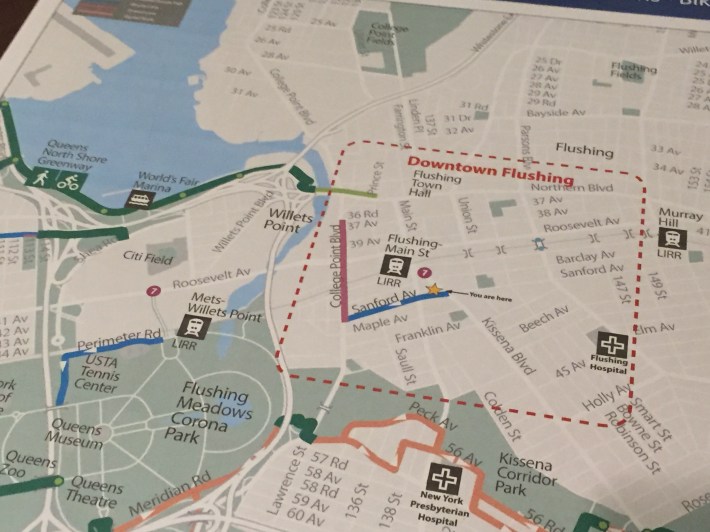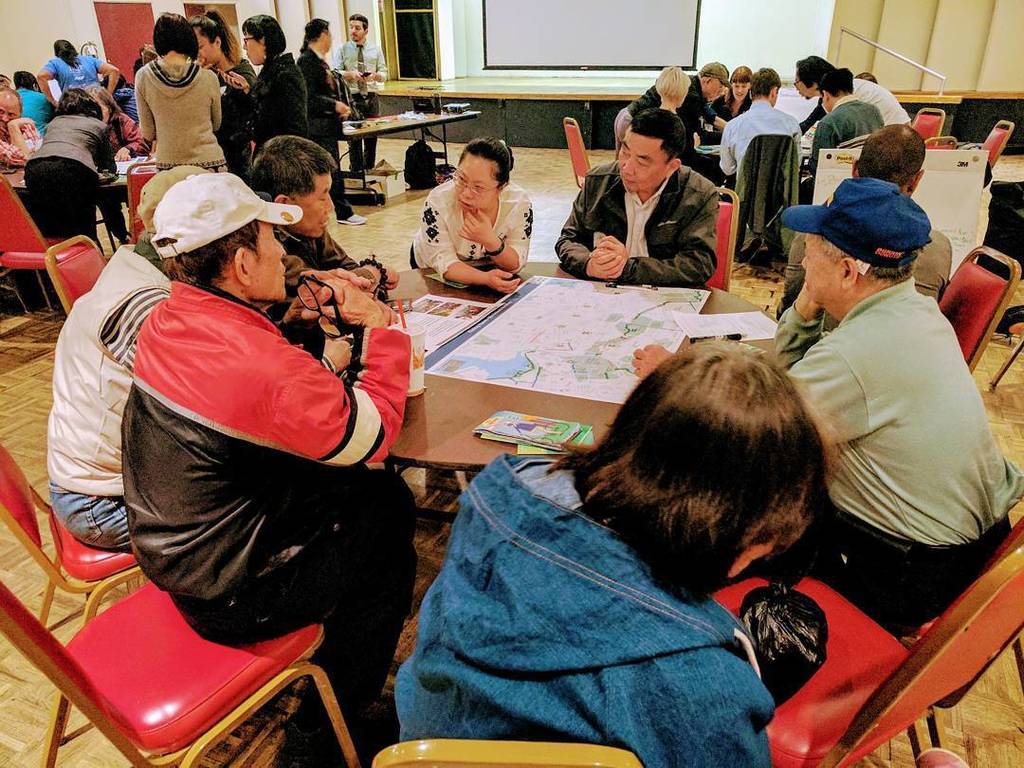Downtown Flushing is one of the most crowded and bustling places in New York City, but getting around on a bike is tough. The streets are crammed with cars, and there is next to no bike infrastructure in the neighborhood. At a DOT forum last night to plan for better bicycling conditions in downtown Flushing, Council Member Peter Koo told the packed room he wants to keep it that way.
"Council Member Peter Koo is against having bike lanes in downtown Flushing," he said. "Biking is good for your health, it saves gas, it’s good for the environment, but it’s not appropriate in downtown Flushing."
Koo did not stick around for the rest of the meeting, but if he had, he would have heard a different story from his constituents, many of whom see biking as the only viable way to get to Flushing's downtown core.
About 70 people, speaking at least five languages between them, turned out last night to talk about the challenges of biking in Flushing. The event was co-sponsored by Koo and the Greater Flushing Chamber of Commerce.
“Hopefully DOT can help us, listen, and address some of these issues through planning and analysis of the streets, and hopefully come to some kind of implementation of specific infrastructure in Flushing that will help improve safety, reduce congestion, and support our businesses," said Chamber of Commerce Executive Director John Choe.
The area around Flushing's Main Street is a major draw and a short, bikeable distance from other densely populated Queens neighborhoods. But at the moment, there aren't any bike lanes in downtown Flushing except for a few blocks of Sanford Avenue. Nearby Flushing Meadows Corona Park is only accessible by cutting through the parking lot of a Home Depot and under the Van Wyck Expressway.

On Flushing's car-oriented streets, biking is a "nightmare," said Jane Liu, a Jamaica Estates resident who grew up in the neighborhood and still bikes there to see her parents. They live two miles away from downtown but drive there. "My father bikes and my mom, she'll be convinced if there's a bike lane, but right now there's no bike lane," Liu said.
"Flushing is one of the major destinations for Asian people to go to," said Kai Chang, a Chinese immigrant who comes into the neighborhood from Long Island. When everyone drives, there is simply not enough room to move and store all the cars. "I usually park my car in the [Kissena Park] area, and then bike to the downtown area," Chang said.
More people would bike into downtown if there were secure places to lock bicycles, said Choe. "You see a lot, in downtown Flushing, people parking their bikes on traffic poles, bus stops, and trees."
Translation services were offered last night in Mandarin, Cantonese, Spanish, and Korean. Suggestions from the Mandarin group, mostly elderly men who use bikes as their main mode of transportation, included signage indicating the presence of bikes and protected bike lanes on 46th Avenue and Bowne Street. Other groups wanted to see safer connections to Corona and Jackson Heights to the west and Bayside to the east.
On his way out of the workshop, Koo told Streetsblog that "public safety" is his main priority, and that there is simply too much bus and car traffic in the area for safe bicycle riding. "If it’s dangerous to bike [here], why take the risk? If it’s really too dangerous, no. Main Street Flushing is really too narrow, especially after the construction."
Koo was referring to the sidewalk expansion along Main Street, which is currently nearing completion. But maintaining the status quo on the streets won't help, Choe told Streetsblog.
"To reduce car congestion we have to consider all the different remedies, including more bicycle use in Flushing," he said. "Because the issue of bike lanes has been so polarized, I think a lot of the older politicians have blinders in terms of what they're willing to consider."
Scott Sieber, Koo's communications director, clarified that the council member could be open to bike infrastructure improvements, including bike lanes.
"This is just a forum. I think [the] councilman was just trying to get some of the hyper reactions at ease a little bit and say, look, you’re not going to wake up tomorrow morning to bike lanes in front of your house," Sieber said.
"If bike lanes is a result of this conversation, you know, we’ll take it from there. If it turns out that the statistics show that there’s a need for it, it’s going to improve safety, and improve congestion, that sounds great. We would absolutely be on board for that."






